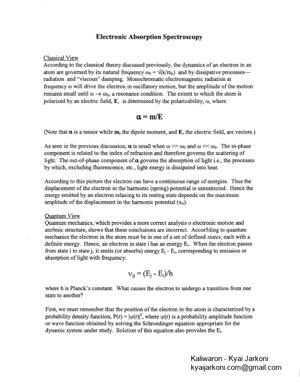Classical View. According to the classical theory discussed previously, the dynamics of an electron in an atom are governed by its natural fiequency oo = .
159 KB – 8 Pages
PAGE – 1 ============
Electronic Absorption Spectroscopy Classical View According to the classical theory discussed previously, the dynamics of an electron in an atom are governed by its natural fiequency oo = .\l(klm,) and by dissipative processes- radiation and “viscous” damping. Monochromatic electromagnetic radiation at fiequency o will drive the electron in oscillatory motion, but the amplitude of the motion remains small until o + oo, a resonance condition. The extent to which the atom is polarized by an electric field, E, is determined by the polarizability, a, where (Note that a is a tensor while m, the dipole moment, and E, the electric field, are vectors.) As seen in the previous discussion, a is small when o >> oo and o << oo. The in-phase component is related to the index of refraction and therefore governs the scattering of light. The out-of-phase component of a governs the absorption of light i.e., the processes by which, excludmg fluorescence, etc., light energy is dissipated into heat. According to this picture the electron can have a continuous range of energies. Thus the displacement of the electron in the harmonic (spring) potential is unrestricted. Hence the energy emitted by an electron relaxing to its resting state depends on the maximum amplitude of the displacement in the harmonic potential (xo). Ouantum View Quantum mechanics, which provides a more correct analysis o electronic motion and ato9rnic structure, shows that these conclusions are incorrect. AccorSding to quantum mechanics the electron in the atom must be in one of a set of defined states, each with a definite energy. Hence, an electron in state i has an energy Ei. When the electron passes from state i to state j, it emits (or absorbs) energy E!, - Ei, corresponding to emission or absorption of light with frequency: where h is Planck's constant. What causes the electron to undergo a transition from one state to another? First, we must remember that the position of the electron in the atom is characterized by a probability density function, P(r) = luC(r)f, where ~(r) is a probability amplitude function or wave function obtained by solving the Schroedinger equation appropriate for the dynamic system under study. Solution of this equation also provides the Ei.
PAGE - 2 ============
Quantum mechanics tells us how an electron can be caused to go fiom one state to another by perturbing its energy. In particular, for an atom exposed to light, it is the interaction of the atomic dipole moment p with the electric field vector of the light, E, provides the perturbation energy V(t), i.e., Then it can be shown that the rate at which an electron passes from state b to state a is where Bab = (2/3)(h2/4n3)-I ~
PAGE – 3 ============
But dI(v)/dt = [dI(v)/dl]*dVdt = cdI(v)/dl. Therefore, -dI(v) = [h~N~B~d1000~] I(v)dl, and so Bab = 2303&~/(N&~), or more generally, Bab = (2303c/Noh) 1 (&(v)/v) dv and so, (cblp(a>f is called the “dipole strength”. Linear Dichroism The dichroic ratio is (A, – AI)/(A,, + Al). This parameter provides information about the orientation of the transition dipole moment(s) relative to the molecular axes. Absorbance Properties of Proteins. \\ Peptide chromophore ‘\. a (nm) x electrons are somewhat delocalized over the N, C, and 0 atoms. An electron in a nonbonding, n, orbital is concentrated near the 0 atom. The Lowest energy electronic transition fiom the peptide bond is an n + n* transition in the range 21 0 to 220 nm and is very weak (because it is symmetry forbidden), E = 100 (M an)-‘. The n + x* at ~190 nm is much more intense, c M 7000 (M an)-‘ and is not polarized along any specific bond. Aromatic Chromophores Figure 7-10 Absorption spectra of the three aromatic amino acids. A log scale has been used in order to display all three conveniently on one graph. [After D. B. Wetlaufer, Adv. Protein Chem. 17: 303 (1962).]
PAGE – 4 ============
Absorbance Properties of Nucleic Acids The nucleotide bases dominate the near W absorption in nucleic acids. There are many n + K* nd n + n* transitions between 200 and 300 nrn. The transition dipoles are in the planes of the aromatic rings. On average E~M) = 10,000 (M cm)-l . Effects of Conformation Hypochromism Linear Dichroism of DNA Figure 7-22 Linear dichroism expected for the B-jonn DNA double helix, when aligned as shown relative to polarized incident light. Because (Yo(t(~,) is in the plane of the base pairs, it is always perpendicular to Ell. The intensity of absorption will be periodic along the helm because the angle between
